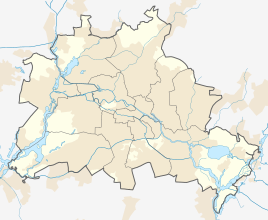Guard barracks (Berlin-Lichterfelde)
|
|
|||
|---|---|---|---|

Former guard barracks, view from Gardeschützenweg. |
|||
| country | Germany | ||
| local community | Berlin | ||
| Coordinates : | 52 ° 27 ' N , 13 ° 18' E | ||
| Opened | 1884 | ||
| owner | Federal Republic of Germany | ||
| Old barracks names | |||
| 1950-1991 | Roosevelt Barracks |
|
|
| Formerly stationed units | |||
|
Guard-Schützen-Bataillon Reichswehr-Schützen-Bataillon 29 Heeresfeuerwerkerschule 6941st Guard Battalion |
|
||
|
Location of the guard barracks in Berlin |
|||
The former guard barracks in the Berlin district of Lichterfelde on Gardeschützenweg has been a property of the Federal Intelligence Service (BND) since September 2003 and is now one of its three main locations in addition to the headquarters on Berlin Chausseestrasse and the BND property in Pullach south of Munich .
Federal Intelligence Service
In 2003 around 1000 BND employees moved into the former barracks after it had been converted for 15 million euros. A three-storey location and information center was added. This meant that parts of the BND should move closer to the federal government before the new Berlin headquarters were completed . Originally, the location in Lichterfelde was to be given up after the opening of the headquarters in Berlin's Chausseestrasse. In the Berlin district of Steglitz-Zehlendorf there were already thoughts about a possible re-use, especially for social and cultural institutions. However, since the BND headquarters does not meet the future space requirements of the service, the property in Lichterfelde is used by the BND on a permanent basis. To this end, the location is to be modernized and converted for around 68 million euros, including around 14 million euros for the new construction of a location and information center.
history
In 1865 the entrepreneur Johann Anton Wilhelm von Carstenn acquired the Lichterfelde and Giesensdorf estates near Berlin with the aim of creating a villa colony for the upper class there. In order to increase the attractiveness of the colony, Carstenn left a plot of land to the Prussian state for the new construction of the Prussian main cadet institute in Finckensteinallee and also had the barracks for the Prussian Guard Rifle Battalion built, which was previously in the barracks built in 1767 on Köpenicker Straße was housed. The construction of the new barracks on the then approximately 60,000 m² site lasted from 1881 to 1884 and was implemented by the government master builder Ernst August Roßteuscher according to a draft sketch by Ferdinand Schönhals . A team barracks for over 600 men, two houses for officers , a gunsmithing building , a drill house , a hospital , two toilet buildings and a horse stable were built.
After the First World War and the establishment of the Reichswehr , the building was initially used by the Reichswehr Rifle Battalion 29, which was part of the 9th Infantry Regiment . In 1929 a renovation took place and the Heeresfeuerwerkerschule moved to the site. In the years 1934 to 1936, numerous further conversions and new buildings were carried out due to the armament of the Wehrmacht . These included a teaching building, a farm building and another team building as well as workshops. The site was expanded from around 60,000 m² to around 80,000 m² to the south. The site currently covers around 85,000 m².
The buildings survived the air raids of World War II without major damage. In 1950 the barracks was renamed "Roosevelt Barracks". From 1950 until the transfer to the former Prussian Hauptkadettenanstalt (under the name Andrews Barracks ) in 1958. Between 1961 to 1991, the service was the United States standing 6941st Guard Battalion stationed in the barracks. Numerous other modifications were made. The buildings of the Heeresfeuerwerkerschule were converted into accommodation buildings and the large parade ground in the center of the facility was converted into parking spaces.
From 1958 to 1961, the district association of the Steglitz Technical Relief Organization and later an office of the Berlin police were housed on the site. In 1991 the USA gave up the "Roosevelt Barracks". The barracks were temporarily taken over by the German Armed Forces , which did not house any offices there. The former barracks is a listed building .
Web links
Individual evidence
- ↑ Katja Colmenares: The old BND location will be retained. In: BZ November 9, 2018, accessed on March 19, 2020 .
- ↑ Ulrich Paul: The Federal Intelligence Service moves to Lichterfelde - and uses sophisticated technology to protect itself from uninvited guests: admission only after a face check. In: Berliner Zeitung . March 14, 2003, accessed March 19, 2020 .
- ↑ Jost Müller-Neuhof: Federal Intelligence Service renews the Lichterfelde location for 68 million euros. In: Berliner Zeitung . January 1, 2018, accessed March 19, 2020 .
- ^ Berlin and its buildings : 1896, section XVIII. Military Administration Building , pp. 383–384
- ^ Journal of Construction . Issue 41. Hochbau 1891, pp. 206–207
- ↑ Roosevelt Barracks ( Memento of the original from February 26, 2017 in the Internet Archive ) Info: The archive link was automatically inserted and not yet checked. Please check the original and archive link according to the instructions and then remove this notice. In: berlin.de . Senate Department for Culture and Europe
- ^ THW Steglitz Chronicle
- ^ Barracks of the Guard Rifle Battalion under the object document number 09065812 in the monument database of the State of Berlin

